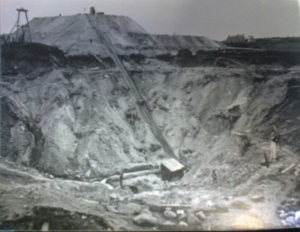So many books seem to be finding their way to the archives when they finally finish their life on the library shelves. Maybe I should make it a permanent column here in the blog? Today we have A History of the Cornish China-clay Industry by R.M. Barton.
The ways of making china was once one of the most well-kept secrets of the world, like Coca-Cola formula or the algorithms of Google. Come to think of it, do you know what makes the thin shell of a tea-cup can stand the searing heat of boiling water?
Clay is not enough. The white kaolin needs other minerals to become a strong china: china-stone, serpentinite, soap-stone… all of those things happen to be or once were mined in Cornwall.
Then they are the pits, where the clay had to be mixed with water and then pumped out. Very different from what we normally understand under a term ‘mining’.
The mined material has to be moved, so the industry made great difference to the infrastructure of the region, most notably the rail and ports.
The pits produce mountains of waste materials that changed the landscape of Cornwall. Interestingly enough, the nature has her own way to colonize the man-made hills.
Of course, I’d be here forever if I wanted to talk about every subject in this book, but I can say two things. It is certainly nice to be able to point out china ingredients from a mineral display while on holidays. It is also nice to realize why the Eden Project’s site is shaped as it is.
August 16, 2016 · 6:38 pm
So much effort for a cup…
Filed under books, long time ago
Tagged as A History of the Cornish China-clay Industry, china clay, china stone, Cornwall China, Eden Project, R.M. Barton


